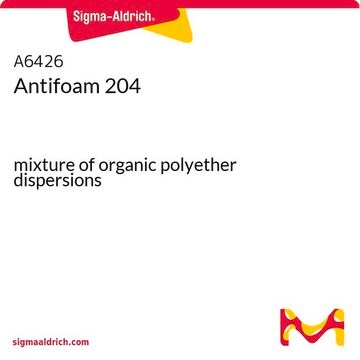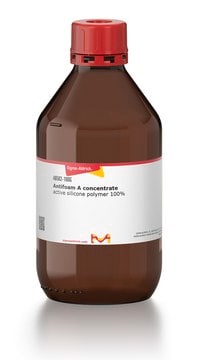A5757
Antifoam B Emulsion
aqueous-silicone emulsion
Synonym(s):
Antifoaming agent B
Sign Into View Organizational & Contract Pricing
All Photos(1)
About This Item
UNSPSC Code:
12161900
NACRES:
NA.25
Recommended Products
form
emulsion
contains
emulsifier (different from those present in Antifoam A emulsion)
technique(s)
cell culture | hybridoma: suitable
microbiological culture: suitable
General description
Antifoam eliminates excessive foaming formed during impingement, due to proteins and/or carbohydrates in the collection medium. Antifoam B emulsion is a silicone based antifoam. Antifoam B emulsion does not affect the growth of bacteria. Antifoam B emulsion functions as an antifoaming agent in shake flask culture of bacteria.
Application
Antifoam B emulsion has been used:
- to enhance collection efficiency in collection media
- as a component in stress granule lysis buffer to reduce foaming, in host cell lysis buffer to reduce foaming caused by detergents
- to improve solubility of antibiotics
- as a foaming controls in bacterial growth media
Other Notes
A 10% aqueous emulsion of polydimethylsiloxane
Storage Class Code
10 - Combustible liquids
WGK
WGK 3
Flash Point(F)
>214.0 °F - closed cup
Flash Point(C)
> 101.1 °C - closed cup
Certificates of Analysis (COA)
Search for Certificates of Analysis (COA) by entering the products Lot/Batch Number. Lot and Batch Numbers can be found on a product’s label following the words ‘Lot’ or ‘Batch’.
Already Own This Product?
Find documentation for the products that you have recently purchased in the Document Library.
High-Throughput Quantification of Bacterial-Cell Interactions Using Virtual Colony Counts
Hoffmann S, et al.
Frontiers in Cellular and Infection Microbiology, 8, 43-43 (2018)
Separation of metabolic supply and demand: aerobic glycolysis as a normal physiological response to fluctuating energetic demands in the membrane
Epstein T, et al.
Cancer & Metabolism, 2(1), 7-7 (2014)
Fermentation pH modulates the size distributions and functional properties of Gluconobacter albidus TMW 2.1191 levan
Ua-Arak T, et al.
Frontiers in Microbiology, 8, 807-807 (2017)
Isolation of yeast and mammalian stress granule cores
Wheeler JR, et al.
Methods, 126, 12-17 (2017)
Celeste J Brown et al.
PloS one, 8(3), e60401-e60401 (2013-03-28)
Observing organisms that evolve in response to strong selection over very short time scales allows the determination of the molecular mechanisms underlying adaptation. Although dissecting these molecular mechanisms is expensive and time-consuming, general patterns can be detected from repeated experiments
Our team of scientists has experience in all areas of research including Life Science, Material Science, Chemical Synthesis, Chromatography, Analytical and many others.
Contact Technical Service







